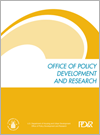
This report describes the community-building approach for public housing managers by explaining what it is, why it makes sense, and how public housing authorities can implement it. Part II discusses how to undertake and nurture community-building activities, including preparing a mission statement, naming a community-building facilitator, creating a representative community organization, and modifying the environment through New Urbanism or defensible space criteria. Part III presents examples of effective strategies by describing successful programs, linking them to community-building principles, and presenting key lessons learned. These programs are designed to restore engagement in the life and government of the community, set community standards, and increase access to opportunities. Part IV lists examples of community-building partnerships with a variety of agencies, such as community foundations, churches, trade unions, business associations, community colleges, and national community service programs. Part V discusses how, in the current context of welfare reform and physical transformation, community building becomes a critical strategy for maintaining social stability and reducing crime, joblessness, and other problems in public housing developments. Community building appears to be the key to helping residents achieve sustainable independence.


